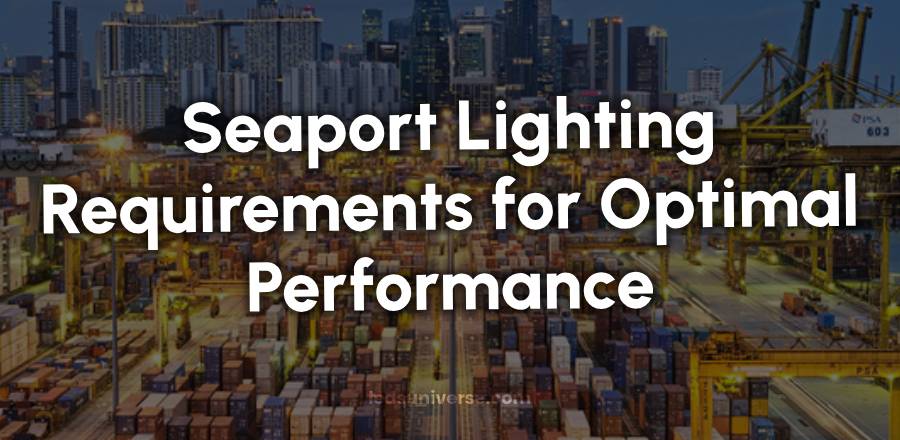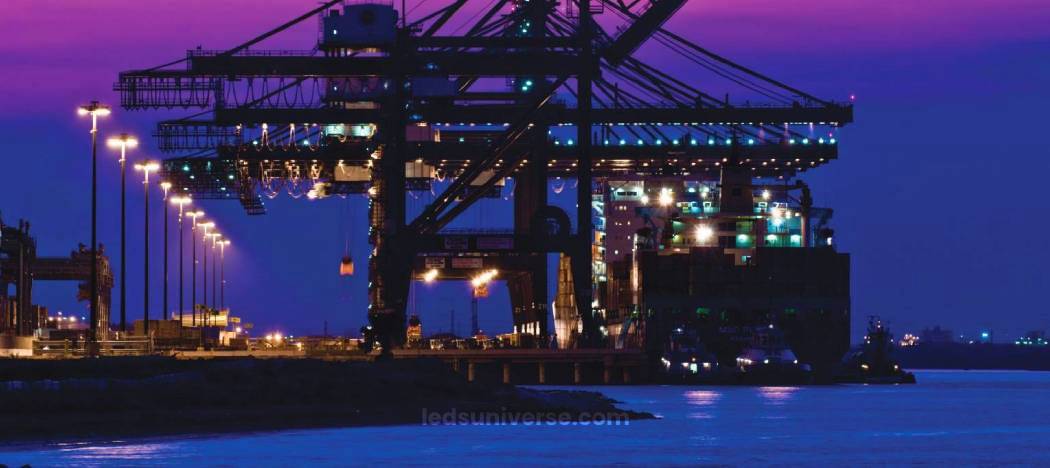
In the world of global trade, seaports are essential hubs that facilitate the movement of goods across oceans. As operations extend into the night, effective lighting becomes vital for safety and efficiency in these bustling environments. However, designing lighting systems for seaports presents unique challenges, particularly from the unpredictable forces of nature—rain and wind. These elements can affect lighting performance and pose risks to personnel and equipment.
As the gateway between sea and land, they handle vast quantities of cargo and facilitate international commerce. The efficient operation of a seaport depends not only on the management of shipping activities but also on the safety and security of the environment. One of the fundamental aspects of ensuring safety and operational efficiency at seaports is the implementation of effective lighting systems. Proper lighting contributes to visibility, security, and overall functionality in various operational areas within the port.
Reach out for free lighting consultation
Table of Contents
ToggleCreating an effective lighting design for seaports involves multiple factors that must be carefully considered to meet the specific needs of each area. Key elements influencing lighting design include:
Different areas within the seaport serve distinct functions, requiring tailored lighting solutions. For instance, the dock area demands bright and uniform lighting to facilitate cargo loading and unloading. In contrast, administrative areas may prioritize softer, ambient lighting for comfort and aesthetics.
Determining the appropriate lighting levels is essential for ensuring visibility while avoiding excessive glare. Lighting designers typically refer to guidelines and standards that dictate minimum illumination levels based on the type of activity taking place. For example, areas where vehicles and machinery operate may require higher lighting levels than pedestrian pathways.

The strategic placement of lighting fixtures is crucial for achieving uniform illumination. Overly concentrated lighting can create shadows and hinder visibility, while insufficient lighting can lead to safety hazards. Designers must conduct thorough assessments of the areas to determine optimal fixture heights, angles, and spacing.
With increasing attention on sustainability and energy conservation, selecting energy-efficient lighting solutions is a priority for many seaports. The use of advanced technologies, such as LEDs, not only reduces energy consumption but also lowers operational costs and minimizes environmental impact.
While effective lighting is vital for the safe operation of seaports, it must also contend with environmental challenges, particularly rain and wind. These factors can significantly affect lighting performance and longevity, requiring careful planning and engineering to mitigate their impacts.

Seaports are exposed to various weather conditions, including heavy rainfall and strong winds. As a result, lighting fixtures must be designed to withstand these elements. Weatherproofing measures, such as using corrosion-resistant materials and sealed enclosures, are essential to ensure that fixtures maintain functionality even in harsh conditions. Additionally, selecting fixtures with appropriate ingress protection ratings can help prevent water and dust intrusion.
Rain and wind can create challenging visibility conditions, especially at night. The presence of moisture on surfaces can lead to reflections and glare, which may hinder visibility for operators and personnel. To address this issue, lighting designers can implement glare reduction strategies, such as using diffusers or directing light downwards to minimize reflections.
In coastal environments, wind load is a critical consideration for lighting installations. The structural integrity of lighting poles and fixtures must be assessed to ensure they can withstand high winds without failure. Designers may need to employ robust materials and structural designs to prevent damage during storms.
Weather conditions also pose maintenance challenges for seaport lighting systems. Heavy rain and wind can lead to the accumulation of debris on lighting fixtures, reducing their efficiency and performance. Regular maintenance schedules must be established to clean fixtures, inspect for damage, and replace any components that may have been compromised by weather conditions.
Utilizing accessible fixture designs can facilitate easier maintenance. For example, fixtures that allow for easy bulb replacement or cleaning can help streamline maintenance efforts, reducing downtime and ensuring optimal performance. Training maintenance personnel on best practices for upkeep and utilizing the right tools can also enhance the efficiency of maintenance operations.
The design and implementation of lighting systems in seaports are subject to various regulations and safety standards. Compliance with these guidelines is paramount to ensuring safe operations and minimizing liability.

Seaport lighting must adhere to national and international standards governing illumination levels and safety. Organizations such as the International Maritime Organization (IMO) and local regulatory bodies provide guidelines that outline minimum lighting requirements for various operational areas. Designers must be well-versed in these standards to ensure compliance and safety.
In addition to safety, security is a paramount concern for seaports. Adequate lighting plays a critical role in deterring criminal activity and ensuring the safety of personnel and cargo. Lighting designs must incorporate strategies to enhance visibility in vulnerable areas, such as access points, parking lots, and storage facilities.
The implementation of lighting systems must also consider environmental regulations aimed at minimizing light pollution and its impact on surrounding ecosystems. Seaports are often located near sensitive habitats, and care must be taken to design lighting solutions that mitigate light spill and reduce disruption to wildlife.
Creating an effective lighting design for seaports involves multiple factors that must be carefully considered to meet the specific needs of each area. A well-thought-out lighting design enhances safety and operational efficiency and contributes to the overall aesthetic appeal of the port environment. The following elements play a vital role in shaping the lighting strategy for seaports:
Different areas within the seaport serve distinct functions, requiring tailored lighting solutions. The dock area, where cargo is loaded and unloaded, demands bright and uniform lighting to facilitate operations and ensure safety. This lighting must be designed to reduce shadows and provide clear visibility for dock workers and operators. The design may also consider the colors of the cargo and the types of containers being handled, as specific colors may require different lighting temperatures for better visibility.
In contrast, administrative areas may prioritize softer, ambient lighting for comfort and aesthetics. These spaces, including offices and break rooms, benefit from lighting that promotes productivity while creating a welcoming atmosphere for employees. This type of lighting can enhance employee satisfaction and contribute to overall morale. It is crucial to consider the functions of each area to select the appropriate lighting levels and types, ensuring that each space is adequately illuminated for its specific purpose.
Determining the appropriate lighting levels is essential for ensuring visibility while avoiding excessive glare. Lighting designers typically refer to guidelines and standards that dictate minimum illumination levels based on the type of activity taking place. For example, areas where vehicles and machinery operate may require higher lighting levels than pedestrian pathways. The International Commission on Illumination (CIE) provides recommendations for minimum lux levels for various tasks, which lighting designers can utilize to ensure compliance with best practices.
Moreover, lighting levels must be dynamic, taking into account not only the time of day but also varying weather conditions. For instance, during foggy nights or heavy rain, the required lighting levels may need to increase to maintain visibility. A flexible lighting design can adapt to these changes, ensuring safe operations in any condition.
The strategic placement of lighting fixtures is crucial for achieving uniform illumination. Overly concentrated lighting can create shadows and hinder visibility, while insufficient lighting can lead to safety hazards. Designers must conduct thorough assessments of the areas to determine optimal fixture heights, angles, and spacing.
Using software simulations can aid in visualizing how light will distribute across the designated areas. This process allows designers to identify potential problem areas before installation, ensuring that every corner is well-lit. Additionally, implementing a layered lighting approach, which combines different types of fixtures, can further enhance visibility and safety. For example, combining high-mast lights with lower-level task lighting can provide both broad illumination and focused lighting where it is most needed.
With increasing attention on sustainability and energy conservation, selecting energy-efficient lighting solutions is a priority for many seaports. The use of advanced technologies, such as LEDs, not only reduces energy consumption but also lowers operational costs and minimizes environmental impact. LEDs have significantly longer lifespans than traditional lighting options, reducing the frequency of replacements and associated maintenance costs.
Moreover, incorporating smart lighting technologies can enhance energy efficiency. These systems can utilize motion sensors to adjust lighting levels based on activity. For example, lights in low-traffic areas can dim when not in use and brighten when movement is detected. This adaptability allows seaports to optimize energy use while maintaining safety standards.
The design and implementation of lighting systems in seaports are subject to various regulations and safety standards. Compliance with these guidelines is paramount to ensuring safe operations and minimizing liability.
Seaport lighting must adhere to national and international standards governing illumination levels and safety. Organizations such as the International Maritime Organization (IMO) and local regulatory bodies provide guidelines that outline minimum lighting requirements for various operational areas. Designers must be well-versed in these standards to ensure compliance and safety.
In addition to adhering to recommended illumination levels, seaport lighting designs must also consider the specific needs of different stakeholders. This includes meeting the requirements of ship operators, cargo handlers, and safety personnel. Engaging with these stakeholders during the design process can provide valuable insights into lighting needs and compliance considerations.
In addition to safety, security is a paramount concern for seaports. Adequate lighting plays a critical role in deterring criminal activity and ensuring the safety of personnel and cargo. Lighting designs must incorporate strategies to enhance visibility in vulnerable areas, such as access points, parking lots, and storage facilities.
Lighting systems should be designed with an emphasis on creating a well-lit environment that discourages unauthorized access. This may include using bright, uniform lighting in critical areas, along with strategically placed fixtures that eliminate dark spots. Additionally, integrating lighting with security cameras can enhance overall security measures by providing clear visibility for surveillance operations.
The implementation of lighting systems must also consider environmental regulations aimed at minimizing light pollution and its impact on surrounding ecosystems. Seaports are often located near sensitive habitats, and care must be taken to design lighting solutions that mitigate light spill and reduce disruption to wildlife.
Adopting shielding techniques can help direct light where it is needed while minimizing spill into adjacent areas. Additionally, choosing lighting fixtures with lower lumen outputs can reduce the overall brightness of the environment, further mitigating light pollution. Collaborating with environmental experts during the design phase can ensure that the chosen lighting solutions are compliant with local regulations and protective of nearby ecosystems.
By thoughtfully considering these lighting design elements, seaports can develop effective, efficient, and sustainable lighting solutions that enhance safety, support operations, and respect the surrounding environment. The integration of innovative technologies and adherence to regulatory guidelines will further contribute to creating a safe and functional environment that supports the seaport’s vital role in global trade.
In the dynamic environment of seaports, effective lighting design is fundamental to ensuring safety, operational efficiency, and environmental stewardship. By carefully considering factors such as area functionality, lighting levels, fixture placement, and energy efficiency, seaports can create tailored solutions that address the unique challenges they face. The impact of environmental conditions, particularly rain and wind, necessitates robust engineering and design strategies to protect lighting systems while maintaining performance.
Compliance with national and international standards is paramount, providing a framework for safety and security within the port. Adequate lighting enhances visibility, deters criminal activity, and contributes to the overall well-being of personnel and operations. Moreover, as seaports increasingly prioritize sustainability, adopting energy-efficient technologies and minimizing light pollution becomes essential.
Through continuous innovation and collaboration with stakeholders, seaports can navigate the complexities of lighting design while fostering a safe and productive environment. By embracing advancements in technology and adhering to regulatory guidelines, the maritime industry can ensure that lighting systems not only meet operational demands but also promote a responsible approach to environmental impact. The commitment to effective lighting solutions will ultimately support the vital role of seaports in facilitating global trade and commerce.